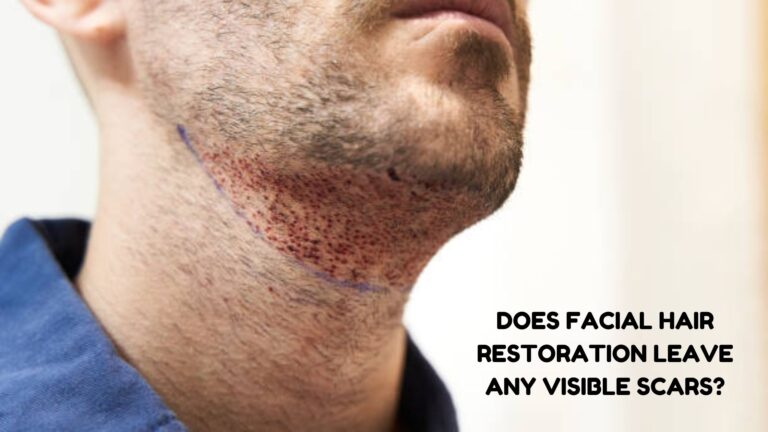Facial hair restoration has emerged as a life-changing procedure for men who struggle with patchy or uneven beard growth. Whether due to genetics, scarring, or hormonal imbalance, the inability to grow a full beard or mustache can affect self-esteem. While many are excited about the possibility of achieving a fuller, more defined facial hair pattern, one question often lingers: Does facial hair restoration leave any visible scars? This article explores the truth behind scarring, comparing different methods and explaining how to minimize marks for natural-looking results.
What Is Facial Hair Restoration?
Facial hair restoration is a specialized cosmetic surgery designed to transplant hair follicles from a donor area—usually the back or sides of the scalp—to facial regions like the beard, mustache, or sideburns. This procedure is commonly chosen by men who have uneven growth or who want to enhance density or shape. The two primary methods used in facial hair restoration are Follicular Unit Extraction (FUE) and Follicular Unit Transplantation (FUT).
Residents in places like Palm Desert are increasingly turning to this procedure, thanks to the availability of top-tier clinics and minimally invasive techniques that deliver natural-looking results.
Understanding Scarring in Hair Restoration
As with any surgical intervention, facial hair restoration carries a potential risk of scarring. However, the severity and prominence of these wounds are contingent upon several variables:
- Technique used: Whether the procedure involves FUE or FUT.
- Skin type: Because of how their skin heals, certain people are more prone to scarring.
- Surgeon’s skill: An experienced professional significantly reduces the risk of visible scarring.
Scars typically form in the donor area, which is often hidden beneath existing hair. In some cases, patients may also experience minimal scarring in the recipient area where the follicles are implanted.
Which Leaves Less Scarring?
The amount and type of scarring largely depend on whether FUE or FUT is used during facial hair restoration.
- FUE (Follicular Unit Extraction): In this technique, individual hair follicles are harvested using a micro-punch tool, resulting in tiny, dot-like scars. These are usually scattered and barely noticeable—even when the hair is trimmed short.
- FUT (Follicular Unit Transplantation): This method involves removing a strip of scalp from the donor area and dissecting it into follicular units. It leaves a linear scar, which may be visible if the surrounding hair is cut too short.
For facial hair transplants, FUE is the more commonly used technique due to its less invasive nature and minimal scarring. Clinics in Palm Desert and other cosmetic hotspots often prefer FUE for its precision and reduced downtime.
Techniques to Minimize or Prevent Scarring
Minimizing scars after facial hair restoration begins with choosing the right clinic and surgeon. Here are some best practices:
- Opt for Smart FUE or advanced micro-punch systems: These tools reduce trauma to the skin and result in cleaner healing.
- Choose a skilled surgeon: A professional with experience in facial hair design can optimize follicle placement and depth, reducing the chance of post-op marks.
- Follow post-operative care strictly: Using prescribed antibiotics or creams, staying out of the sun, and keeping the area clean can help treat infection and promote recovery.
- Consider PRP therapy: Platelet-rich plasma treatments can accelerate recovery and improve scar appearance.
Top-rated facilities in Palm Desert use cutting-edge technology to ensure that scarring is virtually undetectable, especially after full healing.
Healing Process and Long-Term Appearance
Immediately after facial hair restoration, patients may notice tiny scabs or redness at both the donor and recipient sites. This is a normal part of the healing process and typically resolves within 7–10 days.
Over the following months, any minor scarring continues to fade. FUE scars generally blend into the surrounding skin and hair, making them nearly invisible. FUT scars, if present, may be covered by hair or minimized with follow-up treatments like microneedling or laser therapy.
With proper care, the final results are incredibly natural, with no obvious signs of surgery. Clinics in Palm Desert often provide comprehensive aftercare to ensure optimal outcomes and minimal scar visibility.
Real Patient Results and Testimonials
Many men who undergo facial hair restoration report not only satisfaction with the aesthetic improvement but also relief at how inconspicuous any scarring is. Patients often describe being able to shave, trim, and style their new facial hair freely without worry. In clinical follow-ups, most FUE patients confirm that scars are either barely visible or completely unnoticeable.
Conclusion
So, does facial hair restoration leave any visible scars? In most cases—especially with modern FUE techniques—the answer is no, or at least not noticeably so. While all surgical procedures involve some level of skin disruption, today’s advanced tools and experienced specialists make it possible to achieve impressive results with little to no scarring. For those in Palm Desert and beyond, facial hair restoration is not just a solution to patchy growth—it’s a step toward renewed confidence with minimal trade-offs.



